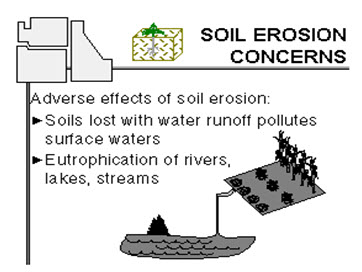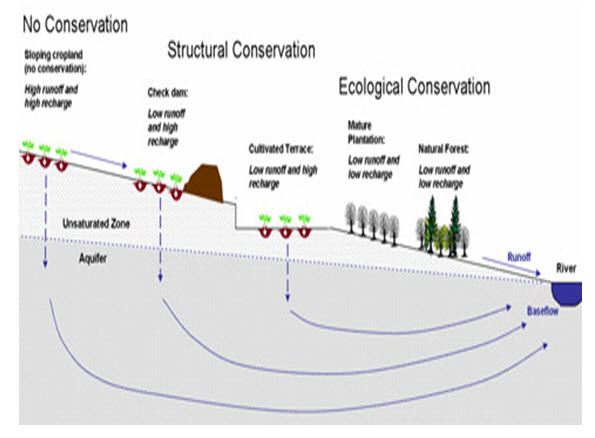Site pages
Current course
Participants
General
Module 1: Formation of Gully and Ravine
Module 2: Hydrological Parameters Related to Soil ...
Module 3: Soil Erosion Processes and Estimation
Module 4: Vegetative and Structural Measures for E...
Keywords
29 March - 4 April
5 April - 11 April
12 April - 18 April
19 April - 25 April
26 April - 2 May
Lesson 4 Factors Influencing Soil Erosion
4.1 Introduction
Soil erosion is mainly caused by the erosive forces of wind and water, besides in varying extents by some other agents, as discussed in Lesson 3. Erosion threatens sustenance of global population with food, nutritional and fiber security, and is closely linked to economy of a country, environmental quality, and human health concerns. Soil erosion by wind and water is the most damaging and widely spread form of land degradation that accounts for 83 percent of the global degraded land. As much as 56 percent of the degraded land is affected by water erosion alone (Oldeman, 1991). Soil erosion affects the water quality; increases flood risk due to elevated river beds on account of deposition of silt carried by flood waters, as well as reduction in general health and productivity of the soil. Erosion results in the reduction of land productivity, reduction in the efficiency of plant nutrient use, damage to seedlings, decrease in plant rooting depth, reduction in the soil’s water-holding capacity, decrease in its permeability, and increase in infiltration rate. The threat that land degradation poses to food security of the continuously growing population is especially worrisome for developing countries. The impact of climate change is expected to further aggravate land degradation in the arid and semi-arid regions of the world. At present, about 20 million km² worldwide are affected by reduced productivity due to land degradation. Twenty one per cent of the arable area shows signs of strong and extreme degradation. These are irreversibly destroyed (FAO, UNEP 1992). A schematic diagram Fig. 4.1 shows the different factors that affect the soil erosion in hilly region.

Fig. 4.1. Factors affecting erosion. (Source: http://www.dartmoor-npa.gov.uk/learningabout/lab-printableresources/lab-factsheetshome/lab-erosion)
4.2 Important Factors
The erosion potential of any area is determined by four principal factors: the characteristics of its soil, its vegetative cover, its topography and its climate. Although each of these factors is discussed separately herein, they are inter-related in determining erosion potential.
i) Soil Characteristics
Soil characteristics influencing erosion by rainfall and runoff are those properties which affect the infiltration capacity of soil and those which affect the resistance of the soil to detachment and transport by falling or flowing water. The following four characteristics are important in determining soil erodibility:
Soil Texture (particle size and gradation): soils containing high percentages of fine sands and silt are normally the most erodible. As the clay and organic matter content of these soils increase, the erodibility decreases. Clay acts as a binder for soil particles, thus reducing erodibility.
Organic Matter Content: Organic material is the “glue” that binds the soil particles together and plays an important part in preventing soil erosion. Organic matter is the main source of energy for soil organisms, both plant and animal. It also influences the infiltration capacity of the soil. As shown in Fig. 4.2, lesser soil organic matter causes deterioration of soil structure and soil permeability.
Soil Structure: The way soil particles are held together, affects the soil's friability, the ease with which soil particles are detached by raindrops and runoff, and the resistance of the soil to the growth of roots and shoots.
Soil Permeability: Permeability is the soil’s ability to transmit air and water. Soils that are least subject to erosion from rainfall and surface runoff are those with high permeability.
ii) Vegetation Cover
Vegetative cover plays an important role in controlling erosion. It:
Shields the soil surface from the impact of falling rain
Holds soil particles in place
Maintains the soil's capacity to absorb water
Reduces the velocity of runoff
Removes subsurface water between rainfalls through the process of evapo-transpiration
iii) Topography
The size, shape and slope characteristics of a watershed influence the amount and rate of runoff. As both slope length and gradient increase, the rate of runoff increases and the potential for erosion is magnified.
iv) Climate
The frequency, intensity and duration of rainfall are fundamental factors in determining the amount of runoff produced in a given area. As both the volume and velocity of runoff increase, the capability of runoff to detach and transport soil particles also increases. Where storms are frequent, intense, or of long duration, erosion risks are high. Seasonal changes in temperature, as well as rainfall influence the erosion risk.

Fig. 4.2. Effect of erosion on organic matter. (Source: http://www.uiweb.uidaho.edu/wq/wqbr/wqbr22.html)
vi) Deforestation and Burning
The loss of forest cover removes the natural protection of soils against the sun's rays and the direct impact of raindrops. There is a reduction in the infiltration of water in to the soil and a simultaneous increase in surface runoff is resulted and the level of organic material is also reduced. These factors necessitate planting on steep slopes. The natural susceptibility of certain soils to erosion, and the coincidence of land preparation with erosive rainfall, accelerate the erosion process and consequently intensify of land degradation.
The above mentioned activities are a part of “Jhum cultivation” or “shifting cultivation practiced in the hilly regions of northern India, particularly north-eastern Indian states. When burning destroys trees, it also damages the flora and fauna, and affects water availability, for example springs. The problem is no less serious when farmers burn crop residues. It is through crop residue that nutrient recycling occurs in nature. The residues accumulate on the soil surface and release nutrients, which are absorbed directly or indirectly being incorporated in the organic matter. With burning, these nutrients are almost completely lost. Another problem caused by burning is the elimination of the supply of fresh organic matter to the soil.
4.3 Scale of Erosion
It measures the extent of erosion. According to scale of erosion, the erosion may be classified as under:
a) Micro Erosion (1mm2 to 1m2)
At this scale, erosion is controlled largely by the stability of the soil aggregates. Soil moisture, organic matter content and the activity of soil fauna, particularly earthworms, have major influences. Erosion in small scale, are identified with sheet erosion and small scale rill erosion.
b) Plot-scale (1m2 to 100m2)
Erosion at the plot scale is controlled by the processes that generate surface runoff. These include the infiltration characteristics of the soil and changes in the micro-topography of the surface related to crust development and surface roughness. The spatial distribution of crusted and uncrusted areas or vegetated and bare soil areas determines the locations of runoff and the patterns of flow and sediment movement over the soil surface.
c) Field scale (100m2 to 10,000m2)
There is usually a reasonably well defined spatial pattern of runoff pathways in locations such as swales and valley bottoms, separated by areas of either inter-rill erosion or no erosion. The extent of inter-rill erosion depends on the severity of the rainfall event so that the size of the area contributing runoff is quite dynamic. The direction of runoff pathways is often controlled by tillage.
(d) Catchment scale (>10,000m2)
Erosion is generally limited to local slope wash, but with higher rainfall, runoff pathways develop over the whole hillside with local discharges into the river; with more extreme events, overland flow and slope wash may be widespread.
4.4 Effect of Erosion
a) Soil Health
Soil health refers to the biological, chemical and physical state of the soil and the maintenance of soil ecosystems. Unlike the impact of accelerated erosion on soil, soil health problems may not be immediately evident, but are no less important.
b) Agricultural Productivity
The loss of topsoil results in the loss of small-seeded pasture plants resulting in lower plant density, whilst loosened soil can result in sandblasting damage from wind erosion in young crops. Soil loss can result in reduction in depth of top soil, decrease in capacity of soil to store water and nutrients and limiting the soil available for root exploration, resulting in reduced root and plant vigour. Deposited soil can bury plants and reduce yields.
c) Downstream Environment
Soil erosion increases with runoff. Management of the soil surface to improve infiltration and soil water storage will improve water availability and crop yields at the same time as reducing erosion. Minimizing soil erosion and runoff has important implications for water quality since runoff usually contains sediment, nutrients, agricultural chemicals or other contaminants. Fig. 4.3 shows that soil erosion due to runoff pollutes surface water and also affects the groundwater as the loss of infiltration.

Fig. 4.3. Erosion effect on downstream Environment. (Source: http://www.uiweb.uidaho.edu/wq/wqbr/wqbr22.html)
4.5 Socio Economic Factors
Socioeconomic conditions such as: poverty, population pressure and agricultural intensification are often cited as the most influential factors causing soil erosion (Kirschke et al, 1999). Especially the impact of population growth with equally increasing livestock numbers and higher pressure on resources is likely to be blamed. In areas where the arable land per capita is declining fast due to increasing population density, it is very likely to result in land degradation.
Anthropogenic activities involving deforestation, overgrazing, intensive cultivation, soil management, cultivation on steep slopes, and urbanization accelerate the soil erosion hazard. Land use and management, topography, climate, social and poverty level is linked to soil erosion. The leading three causes of accelerated soil erosion are: deforestation, overgrazing, and mismanagement of cultivated soils. About 35% of soil erosion is attributed to overgrazing, 30% to deforestation, and 28% to excessive cultivation (FAO, 1996).
(i) Poverty and Marginalization
Financial problem abandon farmers to apply new technique in the farm. The part of the population with the lowest financial resources is likely to adapt changes that appear more profitable. Poor farmers are unable to establish conservation practices.
(ii) Population and Land Availability
Rapid growth of population increases the problem of land scarcity, due to degradation or land use changes (e.g. road construction, settlements, large scale plantations etc). This is especially true when the per capita availability of arable land is decreasing. In India, a reduction in per capita availability of cropped area from 0.365 ha (1951) to 0.219 ha (1991) has been observed along with a fast decline in forest area per capita (Kumar, 2004). In some regions of Africa even a direct correlation between human population density and cultivation intensity could be observed.
(iii) Influences on Land Management
The choice of land use and decisions to change it are influenced by the size of the household, age, gender, education, employment, attitudes, values, and personal traits of household members, site-specific conditions—accessibility, regional land-use structure—as well as by transportation cost, profits, parcel size, competition, costs of production, product prices, public and private financial support, land-management practices, land tenure, and ownership. New cash crops that might appear more promising to small-scale farmers are often more soil-degrading and leave the cultivator highly vulnerable to changing market prices due to his lack of means to invest in conservation or fertilizer (Morgan, 2005). Fig. 4.4 shows how the soil conservation impact on recharge.

Fig. 4.4. Conceptual overview of soil conservation impact on recharge. (Source: http://www.beg.utexas.edu/cswr/loess.html)